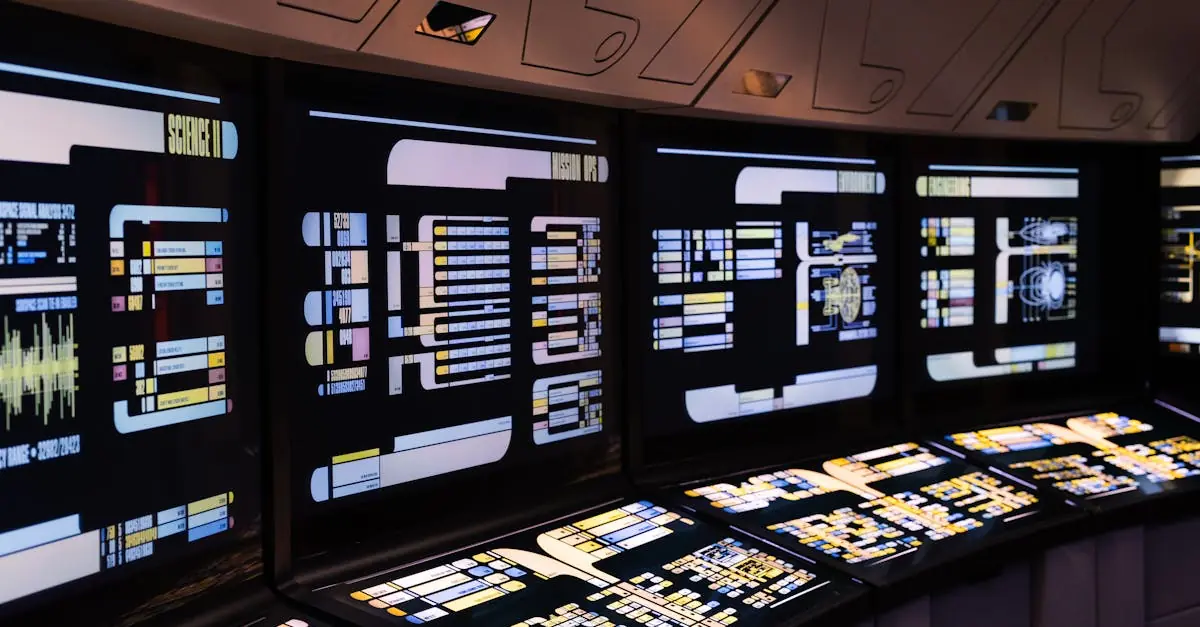Table of Contents
ToggleIn the vast expanse of space, where gravity’s grip loosens and imagination runs wild, space tether systems are the unsung heroes of modern aerospace engineering. Picture this: a giant rubber band flinging satellites around like cosmic frisbees, all while saving fuel and keeping the planet’s budget in check. Sounds like science fiction? Think again. These innovative systems could revolutionize how we explore the final frontier.
Imagine harnessing the power of centrifugal force and momentum to propel spacecraft without burning through precious rocket fuel. Space tethers are not just a quirky concept—they’re a game-changer. As humanity sets its sights on Mars and beyond, understanding these systems becomes essential. Buckle up as we dive into the world of space tethers and discover how they can take us to infinity and beyond, all while keeping our wallets intact.
Overview of Space Tether Systems
Space tether systems represent a transformative approach in aerospace engineering, enhancing satellite propulsion while conserving fuel and reducing operational costs. Their innovative design plays a crucial role in future space exploration missions, particularly toward destinations like Mars.
Definition and Functionality
Space tethers consist of long cables deployed in orbit, leveraging gravitational and centrifugal forces to generate thrust. These systems function by transferring momentum from one object to another, creating acceleration without relying solely on traditional rocket methods. They can stabilize satellites or facilitate orbital transfers, proving essential for planned deep space missions. Understanding their mechanics allows for improved navigation and increased efficiency in space travel.
Types of Space Tether Systems
Several types of space tether systems exist, each with unique applications. Electrodynamic tethers utilize electromagnetic forces to generate thrust, ideal for propelling satellites. A rotating tether system, often seen in tethered satellites, uses centrifugal force to maintain position and stabilize orbit. The momentum exchange tether design allows spacecraft to gain energy by connecting with another object, specifically during rendezvous missions. These various types optimize different aspects of space operations, facilitating innovative exploration methods.
Applications of Space Tether Systems
Space tether systems exhibit versatile applications in aerospace engineering. These applications significantly impact orbital dynamics and environmental management in space.
Orbital Maneuvering
Orbital maneuvering relies heavily on space tether systems, enhancing satellite positioning and trajectory adjustments. These systems permit energy-efficient transfers between orbits, reducing dependence on traditional propulsion methods. Satellites equipped with tethers can maintain or modify their orbits using gravitational forces and momentum exchange. This capability allows for extensive mission flexibility, particularly during complex operations such as spacecraft rendezvous. By utilizing tethers, satellites extend their operational lifespan while decreasing fuel consumption, ultimately lowering mission costs.
Space Debris Removal
Space debris removal emerges as a critical application of tether technology. Through innovative tether designs, satellites can capture and deorbit defunct objects or spent rocket stages. Electrodynamic tethers generate drag in Earth’s atmosphere, facilitating the controlled descent of debris toward burn-up in the atmosphere. This process not only safeguards the functionality of active satellites but also promotes long-term sustainability in space. Implementing tethers for debris removal represents a practical solution for addressing the growing concern of space congestion.
Advantages of Space Tether Systems
Space tether systems offer numerous advantages that stand out in aerospace engineering. They promise substantial benefits both in cost and energy consumption, crucial for future missions.
Cost Efficiency
Space tether systems significantly reduce operational costs. By utilizing gravitational and centrifugal forces, these systems lessen the reliance on rocket propellant, which lowers fuel expenses. Traditional launch methods incur high costs due to propulsion needs. In contrast, tethers allow for a more economical approach to maneuvering satellites.
Governments and private companies can allocate resources more effectively with this technology. Implementing tethers in future missions could result in lower launch costs as teams achieve deeper space exploration within budget constraints. These features make space tether systems a smart investment for the future of aerospace.
Energy Savings
Energy savings represent another key advantage of space tether systems. Utilizing the principles of physics, tethers harness the natural forces in orbit, which reduces the energy requirement for satellite propulsion. Unlike conventional methods, tethers generate thrust without burning excessive fuel, thus enhancing efficiency.
Saving energy translates into extended mission durations as satellites can maintain operational capacity for longer periods. With less energy expended, space tethers contribute to lower overall consumption rates, promoting sustainable practices in space exploration. Consequently, energy efficiency plays a pivotal role in the viability of long-term missions beyond low Earth orbit.
Challenges and Limitations
Space tether systems face several challenges that hinder their full potential in aerospace engineering. Addressing these issues remains essential as experts explore advancements.
Technical Challenges
Complexity in the design of space tether systems poses significant technical challenges. Engineers encounter difficulties ensuring the durability and reliability of materials used, as long cables must withstand harsh conditions in orbit. Tether dynamics complicate operation, particularly when factoring in interactions with other space objects. Additionally, precision in deployment and stabilization requires advanced control systems, which introduce further complexity. Minimal redundancy in these systems can amplify risks, making any failure potentially catastrophic. Innovative solutions must arise to address these technical hurdles effectively.
Environmental Factors
Environmental factors greatly influence the performance of space tether systems. Space debris presents a constant threat, as collisions can damage or destroy tethers. Variations in radiation levels affect the integrity of materials, potentially leading to degradation over time. Magnetic fields generated by planetary bodies can interfere with tether operation and performance. Additionally, proximity to operational satellites can complicate maneuverability, impacting efficiency. Overcoming these environmental factors is crucial for ensuring the longevity and reliability of tether systems in orbit.
Conclusion
Space tether systems represent a significant leap forward in aerospace technology. Their ability to enhance propulsion efficiency while minimizing costs makes them a game changer for future space missions. As humanity sets its sights on Mars and beyond, these innovative systems will play a crucial role in navigating the complexities of space travel.
The versatility of space tethers not only aids in satellite maneuvering but also addresses the pressing issue of space debris. By embracing this technology, organizations can ensure more sustainable practices in space exploration. While challenges remain in their implementation, the potential benefits of space tether systems are undeniable. As research and development continue, these systems could redefine how humanity explores the cosmos.




